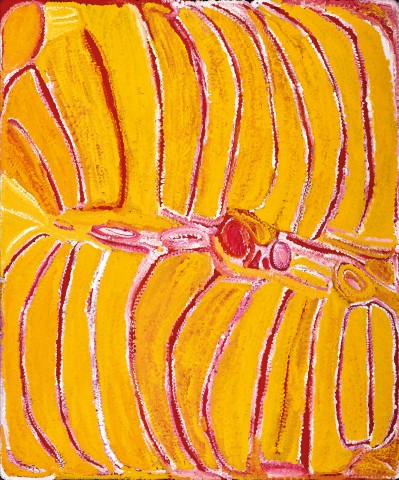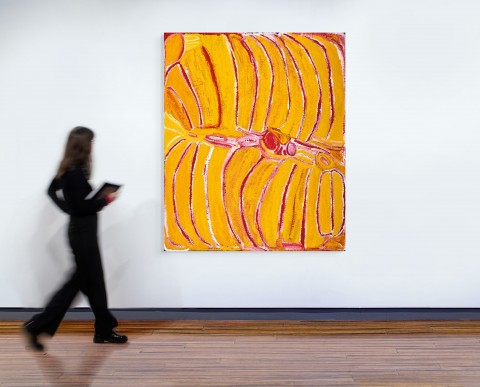KINYU, 2005
EUBENA NAMPITJIN
synthetic polymer paint on linen
180.0 x 150.0 cm
bears inscription verso: artist's name, size and Warlayirti Artists cat. 268/05
Warlayirti Artists, Balgo Hills, Western Australia
Private collection
Sotheby's, Sydney, 20 October 2008, lot 136
Private collection, Melbourne
Nampitjin’s deep knowledge of country, the contours of the terrain, the sacred places and the ancestral beliefs is revealed in her fluent application of luminous colour. ‘I like painting from my heart. My uncle gave me maparn (traditional healing powers) and I have strong spirit. I like to do paintings, big ones, to keep my spirit strong.’1 Nampitjin was a senior law woman and one of the most respected figures in the Balgo community.
Born at Tjinndjaldpa, south of Jupiter Well in the Great Sandy Desert, Nampitjin grew up around Kunawarritji (well 33) further to the west. She moved to Wirrimanu, the present site of the Balgo community in 1964. When her husband Purungu Tjakata Tjapaltjarri passed away, she married Wimmitji Tjapangati. While Tjapangati painted at the Adult Education Centre, Nampitjin taught young girls how to dance and paint for ceremonies, and after encouragement from the Warlpiri women, Nampitjin eventually began to paint alongside her husband. By the mid-1980s, she had produced several works that were included in the 1986 exhibition Art of the Great Sandy Desert organized by the Art Gallery of Western Australia. Further impetus to paint came in 1989 when the new arts organisation, Warlayirti Artists, was formed, providing her with the infrastructure and support to pursue her love of painting and enabling her to focus on major Dreaming Stories.
The white spirit dingo ‘Kinyu’ has been a powerful and constant presence in Eubena’s life and here she has painted her country south-west of Balgo close to Kunawarritji, the home of Kinyu, along the middle stretches of the Canning Stock Route. The majority of the painting shows the tali (sandhills) that dominate this country, while the central circle is Tjurrnu (soakwater) named Midjul, where Kinyu the spirit dog lives. Eubena would often cover Midjul with leaves so Kinyu wouldn't come out and would also leave gifts of goanna for Kinyu.
1. Williamson, S., and Togni, S. (eds.), Eubena Nampitjin; Art and Life, Warlayirti Artists, Balgo, 2005, p. 19

